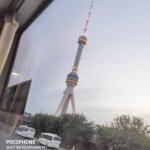Syed Samiullah
A new chapter was added to Pakistan’s maritime story in a quiet but meaningful ceremony at Jinnah Naval Base. A sleek, steel-gray vessel, PNS Yamama, now officially part of the Pakistan Navy, stood tall, not as just another warship, but as a symbol of readiness, resilience, and regional responsibility.
For those unfamiliar with the rhythms of naval development, this might sound like routine news. But PNS Yamama isn’t just another ship. It represents something larger: how Pakistan is preparing to meet the growing demands of maritime security in a world where oceans have become both highways and battlegrounds.
PNS Yamama (274) is the fourth ship in Pakistan Navy’s Yarmook-class Offshore Patrol Vessel (OPV) program, based on the OPV 2600 design by Damen Shipyards Group and built in Romania at Damen Shipyards Galați. These vessels aren’t designed for show they’re built to stay at sea for weeks, monitor vast coastlines, chase down smugglers, rescue sailors in distress, and, if needed, stand their ground in hostile waters.
To answer the question, why does it matter? Let’s take a step back. Why would a country like Pakistan already juggling economic pressures, political challenges, and internal security issues invest in warships? Because oceans matter. More than 90% of the world’s trade moves by sea. Pakistan’s coastline, stretching over 1,000 kilometers along the Arabian Sea, is its gateway to global commerce. Through ports like Gwadar and Karachi, fuel, food, medicine, and raw materials flow in and out of the country. These sea lanes called Sea Lines of Communication (SLOCs) are lifelines and lifelines need protection.
With the arrival of PNS Yamama, the Navy now has a sharper eye on the western coast, where security threats are as much about pirates and traffickers as they are about the possibility of conventional conflict. The ship also plays a key role in protecting the China-Pakistan Economic Corridor (CPEC) a multi-billion-dollar trade and infrastructure project that relies heavily on maritime safety.
Unlike massive destroyers or missile-laden frigates, offshore patrol vessels are more versatile. They’re like utility players on a football team not flashy, but crucial. They patrol. They monitor. They escort. And when needed, they fight.
The OPV 2600 design, which serves as the foundation for PNS Yamama, is the largest and most advanced patrol vessel Damen has to offer. But what exactly does “2600” mean here?
- 2600 tons is the ship’s weight that’s roughly three times heavier than a fully-loaded Boeing 747.
- 98 meters long about the length of a football field.
- It can cruise at 24 knots (that’s about 44 km/h on water) and operate across 5,000 nautical miles enough to sail non-stop from Karachi to Sydney.
The ship can house up to 140 personnel if needed, though typically it runs with a crew of 60. It’s built to stay steady in rough waters able to function in storms with waves reaching 4 to 6 meters high, and survive even harsher seas if necessary.
Does it carry weapons? Absolutely but not heavily armed, since this isn’t primarily a warship. It features a 76mm main gun, similar in firepower to a compact tank cannon, complemented by two 20mm guns for close-range protection. Yet, the true strength of PNS Yamama lies in its sophisticated systems:
- Advanced radar and sensors allowing it to identify and respond to potential threats long before they become critical.
- A dedicated helicopter deck and hangar, essential for swift aerial missions, from search-and-rescue operations to quick-response pursuits.
- Two fast-deployment Rigid Hull Inflatable Boats (RHIBs) for boarding suspicious vessels rapidly and efficiently.
- Most notably, the vessel can carry modular mission containers, customizable add-ons enabling it to quickly adapt rolesranging from mine-clearing operations and anti-submarine warfare, to environmental protection and even serving as a mobile medical facility.
While Damen Shipyards designed and built the ship, a Dutch company named Alewijnse handled one of the trickiest parts the electrical system. Everything from the engine controls to the radar to the power distribution was installed and fine-tuned by their engineers. According to project manager Alex Antohi, this wasn’t just another job it was a collaboration shaped by the specific needs of the Pakistan Navy.
PNS Yamama is not sailing alone in this mission. She joins PNS Yarmouk and PNS Tabuk (both commissioned in 2020), and PNS Hunain, delivered in 2024. These four vessels are part of a broader plan to modernize the Navy’s surface fleet. The goal? A versatile, modular, and responsive fleet of at least 50 vessels, of which more than 20 will be major combat ships.
These OPVs aren’t just for patrolthey’re future-ready. In fact, they can even be upgraded to carry long-range cruise missiles, including Pakistan’s home-produced Harbah missile, capable of striking targets 280 km away. That means these ships aren’t just watchers they can hit back if needed.
Speaking during the ceremony, Vice Admiral Muhammad Faisal Abbasi, said, “The Offshore Patrol Vessels project is an ultimate success not only for Pakistan but for Damen, the Galati Shipyard and all co-makers involved in the conception, design, construction and commissioning of the four OPVs. I am confident that the collaboration between the Pakistan Navy and Damen will further extend to new avenues for shared gains.”
In conclusion, as PNS Yamama sets sail, she embodies more than steel and engineering she reflects Pakistan’s growing commitment to securing its maritime domain and safeguarding vital national interests. Her induction into the fleet marks a strategic step forward, adding not only advanced systems and mission adaptability but also enhancing the Navy’s ability to respond to evolving regional challenges.
More than just a ship, Yamama is a symbol of modern naval readiness, reinforcing Pakistan’s presence in the Indian Ocean with greater strength, smarter capabilities, and a renewed sense of purpose.
The author is the head of the Research Department at Rabita Forum International (RFI) and Associate Editor of Monthly Interaction.










